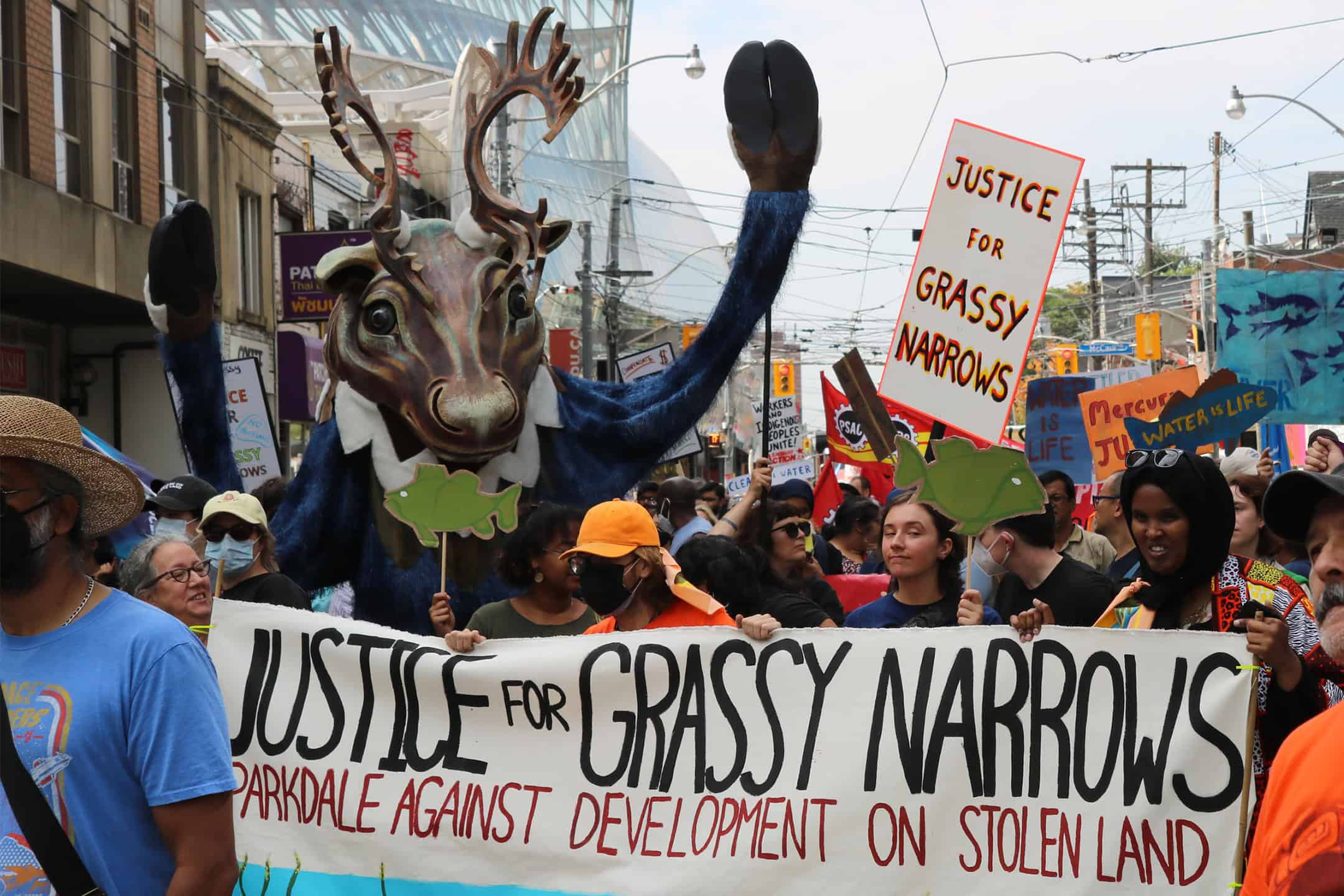Content warning: This article discusses anti-Indigenous racism and suicide.
On September 18, a group of 8,000 demonstrators — including U of T community members — marched to Queen’s Park to demand action for the people of Asubpeeschoseewagong Netum Anishinabek, an Ojibwe First Nation community in northwestern Ontario also known as Grassy Narrows First Nations.
The Grassy Narrows River Run rally originated in 2010 and was organized and led by members of the Grassy Narrows community. The demonstrators marched from Grange Park to the Ontario Legislative Building, where they displayed a 150-square-metre banner that read “Justice for Grassy Narrows” outside the main entrance of the legislature.
Grassy Narrows Chief Rudy Turtle announced the demonstrators’ demands for the federal and provincial governments to compensate the Grassy Narrows community for the ongoing mercury crisis, end industrial threats to Grassy Narrows’ land, and support the restoration of the nation’s way of life before the chemical pollution.
Ahead of the rally, several student groups announced their support for the cause and called on other U of T students to join them in the protest.
Students rally at Queens Park to advocate against mercury poisoning in Grassy Narrows First Nation. OLGA FEDOSSENKO/THE VARSITY
Mercury effects in Grassy Narrows
Mercury poisoning in Grassy Narrows dates back to the 1960s and ’70s when the Dryden Paper Mill dumped approximately 9,000 kilograms of untreated mercury into the English-Wabigoon River system, located 130-kilometres upstream from Grassy Narrows First Nation. In 1970, Ontario banned commercial fishing in the river due to fish containing high levels of mercury. The mill continues to be in operation today.
In June, Grassy Narrows First Nation filed a lawsuit against the federal and provincial government, alleging they violated their duties under Treaty 3 by failing to protect against or remedy the effects of mercury contamination in the English-Wabigoon River system.
The suit shortly followed the release of Western University’s report, which suggested the contamination is being made worse by ongoing industrial pollution from the mill.
In 2017, the Ontario government committed to funding an $85-million remediation plan for the river system. Additionally, the federal government promised to construct mercury treatment facilities for the Grassy Narrows First Nations and the neighbouring Wabaseemong First Nations.
In its 2020 fall economic statement, the federal government committed “$200.1 million over 5 years,” starting in 2021 to address mercury-related health issues and committed to providing $300,000 “ongoing” to build and operate mercury treatment centres in each community.
The river continues to affect the residents of the area to this day. “Because of the [paper and pulp] industry, our children are suffering from neurological problems. Our elders, some of them can barely walk,” Chief Turtle said, during his speech before the rally began. He called on the demonstrators to continue to stand up against the poisoning of their river.
“We are still on the mighty English river and we will stay there as long as the sun shines, as long as the grass grows, [and] as long as the river flows,” he said. “We’re not going away!”
Fewer than 1,000 people live in Grassy Narrows today. Approximately 90 per cent of residents suffer from mercury poisoning, which can cause behavioural disorders as well as harmful effects on the digestive and immune systems, lungs, and kidneys.
In an interview with The Varsity, Annie Sneaky — a member of the Grassy Narrows community — said that Grassy Narrows youth are three times more likely to attempt suicide than young people from other First Nations in Canada because of the neurological effects of mercury poisoning.
“I lost my two sisters to suicide, one of them being my twin sister,” she said. “I’ve lost way too much family to suicide.”
Sneaky’s father couldn’t attend the rally because “he could barely walk” and “[could] barely hold his arms above his head” due to the poisoning.
“That’s why I’m doing this,” she said. “I know that it’s not going to stop in my lifetime… but for future generations, I just hope that they don’t have to be doing this, and I hope that they don’t have to suffer.”
U of T students’ involvement with the rally
On September 17, the University of Toronto Students’ Union (UTSU), the Association of Part-Time Undergraduate Students’ Union, Regenesis UTSG, and the U of T’s Student Environmental Resource Network released a joint post on Instagram, calling on students to, “Join [them] in standing up for what’s right and protecting our rivers for generations to come.”
The next day, UTSU members gathered in front of the Students Commons to join the rally at Grange Park.
The union’s Vice-President Public & University Affairs Avreet Jagdev was in charge of the rally preparations. She talked about the union’s motivations to support Grassy Narrows in an interview with The Varsity.
“Grassy Narrows is [an Indigenous community] that is super geographically close to us… we see it as our responsibility to make sure that we are here, and we are very clear in our commitment to supporting Indigenous communities,” she said.
Jagdev also mentioned that the union had some discussions prior to the rally with Grassy Narrows representatives about how they could promote the rally among U of T students..
In an Instagram post made prior to the protest, student climate advocacy group Climate Justice UofT stated that, “As students, youth, and members of the community, we have so much power when we come together in solidarity.”



No comments to display.